In recent years, cars have become an increasingly central part of CES. This year is no different, as dozens of automotive companies unveiled their latest cutting-edge car technology, laying out their vision for the near future.
Where cars of yesteryear made automotive performance the primary selling point, a big takeaway from this year’s CES is that the car of tomorrow will sell based not solely on how many horsepower it can muster, but rather, how many features it’ll include. These features include self-driving technology, holographic cockpits, modular design and key safety innovations like vehicle-to-vehicle communication and advanced pixel headlights. We teamed up with Verizon to showcase the most impressive car technology at CES 2017.
Betting big on Millennials
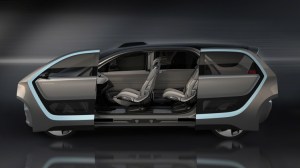
In a nod towards a generation that would much rather spend their time updating their Instagram feed than deal with the hassle of traffic, Chrysler unveiled the Portal Concept, an all-electric people mover that promises to keep you connected while on-the-go. The cabin features a local Wi-Fi network and each seat comes with its own device-agnostic dock for plugging in your Android or iPhone, which is a boon to those who constantly find themselves running out of juice. Each seat also features custom voice recognition technology, allowing each occupant to issue voice commands to set their preferred temperature, seat position, lighting and even music.
On the hardware side of things, the Portal Concept features futuristic, elevator-style sliding doors that open to reveal a 5-foot entry to six interior seats. Thanks to their modular design, the seats can be moved up and down the cabin, or removed entirely from the vehicle to create extra space for hauling cargo. The Portal Concept is also equipped with integrated GPS, radar, ultrasonic, camera, and vehicle-to-vehicle sensors, indicating that Chrysler has big plans to make the Portal Concept a fully autonomous vehicle once the technology and market demand make it feasible.
Forget buttons, it’s all about holograms
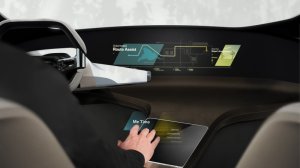
A quick look at modern dashboards reveals a common problem many drivers face today, namely an abundance of small, often hard to reach buttons that make operating a car’s entertainment and navigation functions difficult, not to mention dangerous while on the road. BMW’s answer to this hindrance is the HoloActive Touch system, which incorporates a free-floating touch screen that interacts with driver-facing heads-up display. The result is a Minority Report-esque interface that looks as cool as it is functional.
The HoloActive Touch system builds on BMW’s AirTouch technology unveiled last year and brings the projected user interface right to the driver’s fingertips. An integrated sensor tracks the user’s hand movements, allowing the driver to operate the infotainment system without reaching over toward the center console, and in case you’re worried that you won’t hit the right virtual button, BMW has incorporated haptic feedback in the form of precise air blasts to let your fingers know what buttons their pressing. Much like Chrysler’s Portal Concept, BMW hopes to eventually incorporate the HoloActive Touch system with driverless technologies, a reality which was hinted at during a demo where the HoloActive Touch system was used to order shoelaces on Amazon while on the road.
Putting sharing at the center of the sharing economy
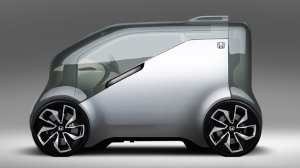
If looks could kill, the Honda NeuV concept car couldn’t hurt a fly. But looks are the least important consideration when it comes to Honda NeuV, which has huge potential in upending the automotive industry. Built from the bottom-up as a car that is destined to join a car rental fleet, the Honda NeuV is equipped with an advanced AI called Honda’s Automated Network Assistant (HANA), which allows passengers in the all-electric car to choose their destination and adjust their infotainment preferences. The onboard sensors will also pick up on the passenger’s mood and emotions, setting music and driving preferences to match for an enjoyable ride. Once at the destination, there’s even an electric longboard that will let the passenger complete the last leg of their journey without hassle.
One of the more interesting things about the Honda NeuV is allowing owners to “rent out” their cars while they’re not in use. And if that’s not enough, the Honda NeuV also lets owners recoup the costs of electricity by charging itself during off-peak hours and selling the excess electricity back to the grid during peak times. This is an ideal scenario for those who only drive when commuting as it allows car owners to make the most of their vehicles while not using them, which turns out to be around 95 percent of the time
Transporting tomorrow
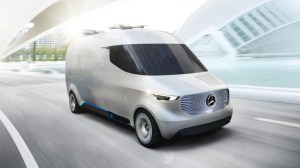
While many know Mercedes as the brand behind luxury sedans, it’s also a significant player in the cargo transport sector with several heavy-duty vans and trucks in its lineup. This piece of Mercedes’ heritage was on full display at CES this year, when it unveiled its Vision Van concept car, a fully autonomous all-electric van that represents the future of package delivery.
Intended as a central component of an automated cargo system, the Vision Van is connected to a logistics system that tracks and monitors its pickups and deliveries from the warehouse to the customer. The emissions-free vehicle is able to drive 167 miles on a single charge, and the loading and unloading of goods is accomplished by a unique “rack” system which shaves off loading time and speeds up delivery. Crowning this achievement is a pair of delivery drones that sit on top of the van that are able to deliver packages weighing up to 4 pounds around a 6-mile radius from the van’s location, which significantly speeds up the fulfillment of same-day deliveries.
Speeding off into the future
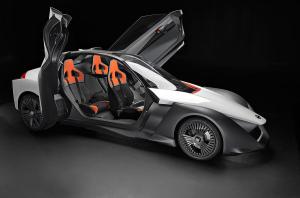
If you’re fretful that the thrill of driving will disappear in the age of autonomous vehicles, then Nissan’s BladeGlider concept car will be sure to delight. The high-speed three-seater is a fresh take on recreational driving, and one that won’t make you feel guilty about emissions, since the BladeGlider is all-electric. The dihedral doors open up to a futuristic cockpit that is inspired after Formula 1 cars, which makes sense considering the powerful drivetrain capable is developed by Williams Advanced Engineering, the same company behind the Formula 1 team bearing its namesake.
The BladeGlider, which is capable of producing 286 horsepower, is able to accelerate to 60 miles per hour in under five seconds, which is impressive considering its heavier-than-expected frame of 2,800 lbs. For driving enthusiasts, the BladeGlider also comes with a custom drift mode, allowing it to take on winding roads and freeways in full confidence. While still a concept car at this stage, the Nissan BladeGlider is a statement about what all-electric cars could be, and considering its commitment to electric cars like the Nissan Leaf, it’s more than likely you’ll see the BladeGlider on the street sooner than later.
CES 2017 is full of exciting new concepts that will change the way we live. As our everyday activities continue to further integrate with our smartphones, we’ll have more and more control at our fingertips. Verizon keeps you connected to all the things that matter, with the latest devices on the best network.